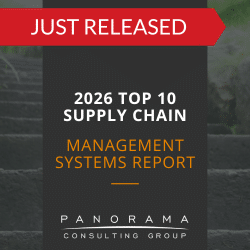There is nothing magical about “lean manufacturing” or “lean thinking,” yet the adoption of lean practices can bring companies huge benefits in competitiveness and profitability. Lean methodology uses pragmatic, proven tools and techniques to systematically identify and eliminate different types of waste within business processes.
The application of lean principles during an ERP implementation results in significant cost savings, improved quality and enhanced delivery within manufacturing processes. Lean concepts and methodology can be applied to service and administration processes as well.
To apply lean manufacturing to business processes, organizations should adhere to the following five principles:
- Identify what creates customer value (from the customer’s perspective)
- Identify the different steps within the process chain
- Streamline the processes
- Produce only what is consumed by the customer
- Strive for perfection by continuing to identify and remove waste
2022 Top 10 Manufacturing ERP Systems Report
Which manufacturing ERP systems have the strongest functionality? Learn about the systems with the most advanced capabilities in our unbiased report.
One objective of lean manufacturing is to shorten the amount of time to process a customer payment from the time of order. This is achieved by first identifying and then removing waste steps within a standard quote to cash process. Potential areas of manufacturing waste, or “muda,” include:
1. Over-production of material: Manufacturing material before an item is required can lead to overproduction. It’s important for companies to practice ‘just in time’ vs. ‘just in case’ inventory management. Schedule and produce only what is necessary and needed to ship immediately.
2. Excess inventory: Work in progress (WIP) is a direct result of overproduction and waiting. Excess inventory tends to mask production floor issues and can result in increased lead times, minimized production floor space and decreased communication. Create a seamless workflow between work centers to help minimize the amount of WIP inventory on the production floor.
3. Transport time: Transporting product between processes adds no value to the product, and can result in the overall deterioration of the product. Map out product flows to determine which processes belong next to each other.
4. Processing time: Companies tend to use larger, more expensive equipment to perform simpler tasks. Invest in smaller, more flexible equipment when possible to reduce high asset costs, reduce manufacturing cells and combine steps within a process to gain efficiencies.
5. Wait time: Wait time occurs when goods and materials are not being processed. One hour lost in a bottleneck process results in one hour lost in overall output. Link processes together so one process feeds directly into another process to reduce wait time.
6. Operator motion: Operator motion refers to physical actions such as stretching, bending, pulling, walking, lifting and reaching required of operators within a process. Tasks that may require such physical motion include machine set up and the movement of product across the production line. Document, analyze and redesign processes to eliminate excess movements, gain improved efficiencies and reduce overall labor costs associated with the process.
7. Poor quality: Quality defects that result in rework and scrap can have a high cost impact on an organization. To reduce quality defects within a process, focus on the six areas of waste identified above and invest the time and effort required to engage in ongoing continuous improvement activities.
Lean manufacturing is a methodology that can be applied to ERP implementations in both large and small organizations. It is a mental approach to work that uses a defined set of principles and focuses on removing waste. One improvement gained leads to another improvement opportunity identified. Lean thinking is not about the destination but rather the journey to continuous process improvement.













